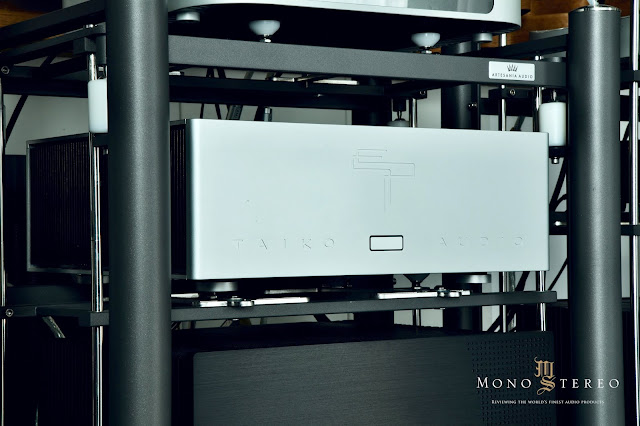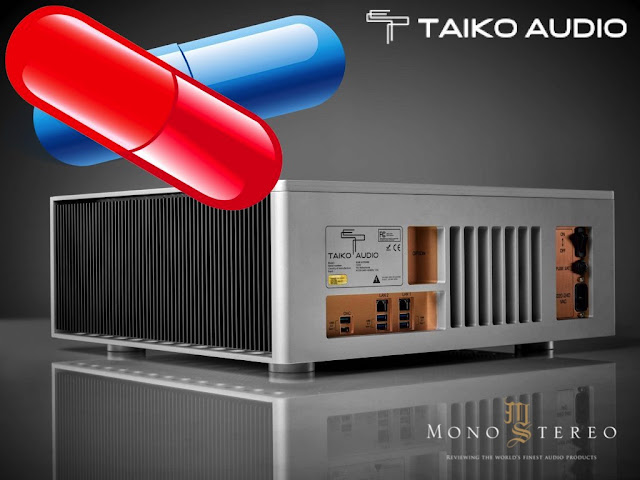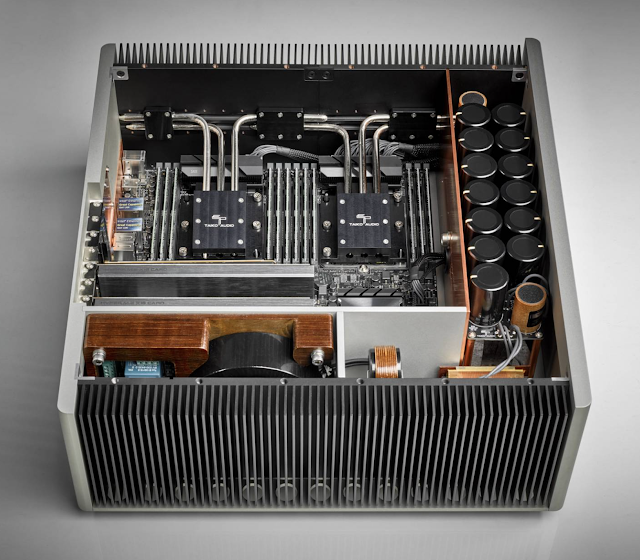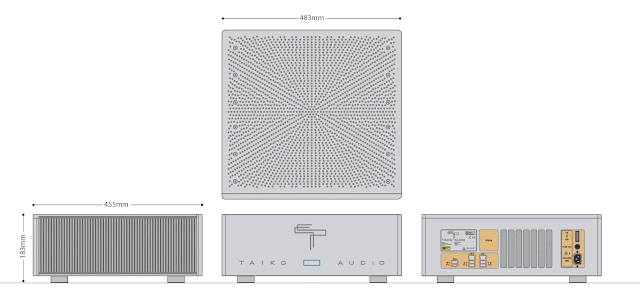Due to the frequency of inquiries about the various aspects of setting up digital front-ends and general questions about top-level digital reproduction, the subject of digital audio, its associated paraphernalia, and its complexity has become a rather daily undertaking. We have reached a point where everything related to the reproduction of music through digital consumption has its degree of sophistication and complexity. Each and every detail matter and contribute to the final outcome.
My introduction and involvement with Taiko Audio began with an invitation to the special kick-off event at BMW Welt in 2016 during the Munich High-End Audio fair. With so many commitments/meetings at the show and afterward, it is never easy to decide which to attend and which to leave out. But I am more than happy that I was present at the initialization of the SGM music server as what followed is way more than just a story of success.
In just a few years, under the leadership of Emile Bok Taiko Audio has shaken top tier digital front-end market and utterly shifted the perspective of how audiophiles and music lovers look at computer-based music servers.
 Fast forward to the middle of last year. Emile Bok visited me personally and installed the Taiko Audio SGM Extreme review unit. We spend all day immersed in the digital world. All I can say is that after the first impact, it was not easy to get back into usual realms once you are affected by the Extreme bug.
Fast forward to the middle of last year. Emile Bok visited me personally and installed the Taiko Audio SGM Extreme review unit. We spend all day immersed in the digital world. All I can say is that after the first impact, it was not easy to get back into usual realms once you are affected by the Extreme bug. During the installation, we spent almost an hour or two just moving the music server on the Exoteryc high-end audio rack by Artesania Audio, millimeter by millimeter, and the difference was amazing. More than a dozen times we just looked at each other in amazement and both of us nodded quietly.
This “experiment” has clearly shown that SGM Extreme is remarkably sensitive to any change, making it possible to accelerate performance to what its sheer name suggests: the Extreme!
EXTREME COMPUTER AUDIO!?
Like everything in high-end audio, digital is no longer a question of trial and error. Many of us who have been involved with computer audio in one way or another began to play with different combinations of built-in, off-shelf, or retrofit parts. The results varied for many reasons. Many lost their interest in the search for perfection, but a few discovered some degree of sonic nirvana. As you can read on, it takes a tremendous amount of time to reach the sonic sweet spot, and with all the unknowns associated with the software, it takes even longer to contain it.
As has been proven recently, a basic or even deeper knowledge of computers and components is no guarantee of building a high-end audio server with a satisfactory result. Those more closely associated with the SGM Extreme or Taiko Audio know that a number of computer-savvy hardcore listeners have received the SGM Extreme even though they have built their own, over-specified, state-of-the-art music servers. But why…
During the evaluation, I followed Bok’s tip and tried different settings of the Ethernet. What at first glance seems to be a causal adjustment of little or no importance turned out to be a major sonic shift. I dug deeper but felt lost in an endless universe, and Bok came to my rescue with his established and sonic proven settings.
The difference in sound was in the order of magnitude of the change from one type of preamplifier to another. Imagine the level of a solid-state preamplifier compared to a tube preamplifier. Two different, not exactly opposite settings caused the variance that amazed me. How can an Ethernet network setting affect the sound this way! Even theoretically it should not be what you would say about sound effects in the real world… But to be reasonable, I listened a lot critically. Over and over again. No placebo effect!
This of course opens up new territory and clearly points to something strange: the importance of integrating software and hardware and the interchangeable potency! We are already mentally prepared and acceptable for the hardware changes and the resulting sonic differences. But software!?
To a certain extent, some of the audiophiles and music lovers have explored various playback software, software plug-ins, etc. But this might rather fall under the label of the general software agenda associated with different applications and programs.
Here we enter the area of the nth degree and deal with the Russian doll phenomena of several Pandora Boxes, which are within the Pandora Box! Every time a new layer is revealed, more questions and amazing findings are waiting to be discovered.
The main question remains how all these non-subtilities can be addressed, recorded, and objectively verified. How can they be relativized and put into a sustainable form? This is far above curiosity on both fronts; from the reviewer’s point of view and from the manufacturer’s, from a technological point of view.
Bok follows his logic from past IT experiences by comprehending the rules of scientific methods. All scientific observations require severe data point acquisition. I cannot even imagine how much time and effort Bok and his team have spent alone exploring the Ethernet settings and collecting the necessary data to firmly lock two “factory” recommended settings, which I jokingly referred to as the red and blue pill.
Obviously, we are still missing a few pieces of the puzzle and a clear explanation of what makes the sound quality in such a complex product as the SGM Extreme server. What is known and what is a fact is that with every positive improvement in sound quality we learn something about what is really important in the digital/computer domain.
A general observation. We cannot say that research and development in the field of analog and turntables have stopped. There are many products on the market that push analog to the top. However… It is a fact that everything that has to do with computers (and basically music servers are computers) works in completely different dimensions. In the computer field, technology is not only driven by a consumer market, but also by the highly demanding professional IT industry, where the demands for progress in resolving complex tasks and solving real everyday computer problems are of paramount importance. Not just ones and zeros for solid audio craftsmanship :).
What Bok and Taiko Audio do with the music servers of SGM Extreme falls, so to speak, into reverse engineering Modus Operandi. By reverse action, they try out hundreds if not thousands of possibilities, take a seemingly endless stream of memos and find a node where different settings provide a reproducible sonic benefit.
The more data points are collected, the better it is understood which effects influence the sound quality in which way. The sum of several findings results in a final product which – whether you like it or not – is voiced! As controversial as this may sound, especially in the digital domain and even more astounding in the computer-aided environment, this is a proven fact. So does Taiko Audio work on the fringes of science? Yes and no.
What distinguishes Emile Bok and Taiko Audio is its heritage. Since he is both an IT expert and an extreme audiophile, many discoveries address both poles: the technological and the sonic. With Bok’s track record on both sides, the balance in terms of market acceptance seems more than right.
The analog should not be seen as an opponent. It took decades, more than a hundred years to refine and bring vinyl reproduction up to the latest state of the art. With digital sound, we are finally entering an era in which rapid development has made a necessary technological breakthrough possible, and it seems as if we are only scratching the surface of what is possible.
Here I see my role as an assessor. To report on these discoveries and to share these discoveries that go beyond me or Taiko Audio. They are important for the development of our still niche industry.
DIGITAL VS ANALOG!?
With SGM Extreme, I am looking for far less of that particular analog thrill, which to a certain extent is undoubtedly associated with a few special peculiarities. Analog has its strong native advantages, but the digital counterpart also has its own advantages.
Magnificent features of the best virtues of tape machines and finest vinyl playback have never been so familiar or so alarmingly positive as they are in the digital world today. And this résumé comes from an analog fanatic who, not so long ago, could hardly bear the unpleasant digital features for more than one or two songs.
A lot has changed in the last ten years, and the digital does not have to be compared so hectically with the analog. I believe that state-of-the-art digital reproduction has finally reached the point where it has a life of its own.
The whole agenda is somewhat complex and complicated, but we are getting to the point where we should perhaps stop lurking in the past and accept what the music material of the past and 21st century has to offer.
Some of my most recent reference music was recorded only a few years ago, and they do not shy away from great tonal virtues. We may not have the lavish luxury of the iconic recordings, performers, conductors, and orchestras of the 1950s, 1960s, and 1970s. But… If you take some time and have the will to explore, there is a whole lot of fascinating new music that is exceptionally well-recorded.
SGM Extreme picks up the important point I mentioned in my earlier articles. On the top level, it is no longer about analog vs. digital. It’s more about embracing both sides, seeing music for what it is, and no longer competing in two different fields, as was popular in the past. It’s time to appreciate both worlds and see their juxtaposition as different ways to achieve the ultimate goal.
These qualities are therefore more worthy of being described as one step closer to the core of the music and not juxtaposed. The omnipresent conflict with analog vs. digital finally sees the balancing act as the digital advantages cannot be ignored, since they are by no means marginal. And Extreme SGM music server is a rare gem that allows such a major step-up.
THE MUSIC
The recent introduction of the updated Nagra HD PREAMP to the NAGRA HD HV version in my reference system has produced exceptional results in both digital and analog terms.
The system, which works with the SGM Extreme music server from Taiko Audio, followed by MSB Technology Select and Nagra HD PREAMP HV, brings revelations that I have never encountered before.
I am a strong advocate of systemic gain, and it is an art in itself to get it right. With all the possible permutations and different outputs (mV), cables, etc. it is never easy to get it right. Even within the same branded audio products, the synergy is not essential.
This review deals with the analog and digital thorough the text for many of the important reasons.
With the help of the Nagra HD PREAMP HV, the Thrax Audio Dionysos phono preamplifier, Taiko Extreme, and the MSB Technology Select DAC, I was able to achieve the exact gain matching I needed to go deeper into the secrets of the analog and digital worlds and, for the first time, make a unique and, dare I say it, revolutionary discovery and a balancing act that, instead of separating, creates a pleasant fusion of what was considered to be an eternal rivalry.
There are many good examples of music in reference quality, but a practical example of this particular discovery is a debut album by Counting Crows.
August and Everything After Analogue Productions 45 RPM Vinyl Record compared to the latest Qobuz High-Definition-Streaming-Album revealed something extraordinary. Please note that we are talking about streaming and not about files from the hard drive! This is the subject of a separate essay.
The Qobuz version and Analogue Production plated and pressed by Quality Record Pressings, mastered by Ryan Smith, Sterling Sound which expands to four sides, maximizes the dynamic range of the recording, which was equivalent to the Qobuz version or exceeded in a few attributes. But… To make things even more complex, the Qobuz version stood out on its own with a few parameters that competed with a large dose of the antidote.
When listening more relaxed and not ultra-critically, the differences felt to be smaller and not immediately obvious. Yet, even slightly more efforts easily proven that this is not the case.
To keep it beyond self-deception, this was confirmed a few days later by two hard audiophiles and music lovers. One of them is considered to be one Golden Ears with decades of track record in dealing with top-tier high-end audio products and systems.
The result was so astounding for these extremely critical listeners that they were completely pushed out of the safe zone by rethinking their firm convictions. As I learned later, the word quickly got around and caused quite a stir among peers.
What is the secret to getting to the point where all these qualities became apparent? Is it a combination of Taiko Audio SGM Extreme and Nagra HD PREAMP HV that, together with MSB Technology Select DAC, makes these discoveries possible?
In the first part of the Nagra HD PREAMP HV, I addressed the issue of the correct timing between the fundamental frequency and the overtones of the notes. Taking into account the temporary resolution of the ear and maintaining the phase could be the reason for this. Timing is all too often overlooked, but it brings back an important insight from some time ago and the Taiko Audio Extreme music server brought these exact aspects into the focus.
I had the luxury of listening to direct digital and analog masters in the studio coming from the same original feed. The differences between the two were marginal, and the sound quality was equal. What is the reason for this proximity?
It seems that something is inherently right with the analog in terms of timing. This particular issue has never been touched upon in any substantial way since the usual attention to analog is not related to timing or phase. Yet, the Extreme server has proven continuously to nail this exact trait beyond well.
The logic of these findings brings more than interesting facts that not only point to the future mechanics of ultra-high-end audio but also lay the foundation for it and the Taiko Audio music server comes with pivotal gradients to let these aspects to come to life.
Here are some of the tracks that easily and immediately bring out the extreme potency…
Miroslav Tadić and Vlatko Stefanovski Treta Majka show very much how incisiveness at the given frequencies could not only fully elaborate and fulfill the required frequency spectrum, but also bring out the full effect of the music. Taiko Audio Extreme lingers on in the aura and has managed to reveal a greater sense of interplay and energy as well as the interactive part.
This was further confirmed with Harry Connick, Jr. True Love: A Celebration of Cole Porter. Most notably with “All of You” and “Mind If I Make Love to You” where the engagement factor went to the ceiling with Extreme SGM, showing something extraordinary in terms of the ability to captivate the listener and create a true balancing act at the reference level.
The “Luscious” from Chanson du Vieux Carré is a pure exhibition of expression and fun engagement Harry Connick Jr. Here, too Taiko Audio Extreme has reached a level of its own by setting a tempo that should by no means be associated with the digital. But it does!
On the analog side, the Harry Belafonte’s Belafonte Sings the Blues and Belafonte: At Carnegie Hall, they represent one of my favorite records of all time because they provide the factor of being there and above the usual interactivity.
“Loosing Hand” shines with an immediacy that was not only on the side of my analog opponents. With Taiko Audio Extreme SGM, the factor of immediate involvement was not rushed but firmly established and revealed. I never expected something like this to happen in the digital realm.
The same qualities showed up with “Sylvie” from Belafonte: At Carnegie Hall with even more subtlety and feeling of naturalness, that was brought to the point with Jack Lee & Bob James “Love Me As Though There Were No Tomorrow” from the album Botero. Here the instruments were fixed so that a fluidity and pinpoint presence could develop naturally, without calling for their forced discovery.
The extreme ability of the staging and separation of the voices was clearly different in Ariel Ramírez, Guido Haazen, Christal Rheams, Manuel Melendez, ,, José Sacin, Pablo Talamante, Washington Choral Arts Society, as Joseph Holt well as the dramatic rendition of the resolution.
Marcin Wasilewski Trio, Marcin Wasilewski, Slawomir Kurkiewicz, Michal Miskiewicz “Green Sky” from the album Trio delivered a higher resolution as it did Joel Grare Des pas sous la neige, especially the tracks “Le cou des vaches (À mon frère Alain)” and “Les Grandes Jorasses Face Nord (À Yvan Cassar)” with a foundation of harmonic richness that is of astonishing effect.
Here, harmonic density and dynamics enter a completely different league with a spectral resolution of a completely different magnitude.
Hans Zimmer Live In Prague Hans Zimmer “Aurora”, “Inception” are another tour de force when it comes to complexity and resolution. When the going gets tough there is no excuse for collapsing when it gets busy. With “Crimson Tide/160 BPM” the bass performance and thunderous expansion Extreme got the fundamentals ghastly right. Taiko easily entered into the low resonating concert hall space mode far beyond the usual scope and with the authority of cinematic dimensions.
And the final word on the extreme ability to reproduce the astonishingly dynamic presentation without even remotely entering the realm of distortion was finally proven with more contemporary heavy league sound material.
Deadmau5 – W:/2016ALBUM/ “Imaginary friends”, Infected Mushroom Army by Mushrooms “U R So F****d” as well as Trentemoller from the album The Last Resort “Snowflake” and “Chamelon”, which encompass the low-frequency foundation to the nth degree.
These tracks bring reality to an endgame and, to make matters complicated, this music material needs and presents a different level of dynamics that is not easy to fasten. These three albums and these tracks are in the realm of a deeper level of objective structure, not just in terms of forming the lower layers. They call for a holistic approach, without interfering with the very basics.
And Taiko Audio SGM Extreme brings out the very last notes that fall like stones in the air, with an extremely elegant articulation that preserves the essence despite the utterly heavy need for the materialization of the core music foundation.
Unlike most digital front-ends, the Extreme music server has managed to maintain a stable balance across all music genres without failing. That alone is worth all of the praise and highlighting.
SUM UP
“The future is already here — it’s just not very evenly distributed.” – William Gibson
The future is now! There has never been a better time to enjoy the music if you love music for what it is. My crazy correspondence, which has only intensified in the last few months has revealed how not only strictly digitally oriented music lovers and audiophiles ask me about the upper level of digital reproduction. It’s more than interesting that hard-core analog lovers are seriously considering or already adding the latest upper echelon digital front-ends. Maybe it’s time to stop the meticulous search for the shortcomings, and start appreciating the varieties and enjoying both to the fullest.
It’s becoming more and more interesting within the digital domain, and I hope that we will be able to explore much more high-definition music that is offered and enjoyed, allowing us to bridge the gap between the great analog mastering of records and the digital masters.
Taiko Audio SGM Extreme – Dual Intel Xeon Scalable 10 core – 20 thread CPU’s with twelve 4Gb custom order industrial memory modules for 48Gb in total might sound like an overblown and over-specced affair in theory, but in reality and when addressing the utmost performance such “loaded” machine matters a lot when it comes to running the software most potently.
Like in the analog realm, it takes a lot of effort to advance the digital to the state of the art level. Yes, you can get considerable results even with the low-level processing power, but in the upper echelon dealings, every little detail matters, and processing power seems to be of high importance. This is where satisfying sonic delivery differs from an enlivening experience and Taiko Audio did their homework beyond well with SGM Extreme’s parts and execution.
SGM Extreme is a technological tour de force by itself. When partnered with matching components of a similar level of performance the digital audio finally shifts to a new plane, which was unattainable a few years back.
I don’t think that an initial goal of the Taiko Audio flagship music server was to deliver an ordinary, instantly pleasing, or saturated performance. Similar to the ultra performing sports cars, where one expects a certain thrill and more devoted experience, translating into the fully immersive encounter with the road and fathomless handling that can profoundly explore the terrain and let you enjoy the actual ride, Taiko Audio SGM Extreme grants the pure music enjoyment where the recordings grants such extreme pleasure.
Have no doubts Taiko Audio flagship music server does deliver a grander potion of captivating music enjoyment even with the mediocre music material. It’s just not flattering the mistakes being made. Poorly sounding recordings sound accordingly. On the other hand, exceptionally well-recorded music portrays the sonic illusion scarily close to reality. Clarity of form so to speak.
SGM Extreme has penetrated the market in the digital audio’s finest momentum, where the borderlines with the analog are getting crossed or shockingly to some, even surpassed. While this can be a highly touchy perhaps the newly introduced qualities of digital need not to be compared to analog pole. We should allow them to simply differ.
Again, not everything can be oversimplified to the nth degree. This is the major problem of the times we’re living in.
Every little detail matters. The digital audio is no exception. Over the past few months, I’ve learned to fully appreciate and somehow understand why Taiko Audio has undergone such a painstaking effort on all fronts. Impressive innards like 400VA transformer, Lundahl chokes, 700.000uF of Mundorf and Duelund capacitors, copper heatsinks, etc.
The list goes on. Imagine the needed time for drilling 6000+ holes on the chassis for the optimized heat dissipation and utterly optimized and CNC-ed shape of the SGM Extreme enclosure. It takes several days just to machine a single server chassis and this luckily not only reflects in the premium price sticker but most importantly in the performance :).
I would say the balancing act of the bang for the buck is weighted a bit differently with Taiko Audio SGM Extreme than what’s considered the usual norm. Ordinary logic follows a few percent performance gains, closely connected with the premium price, as seen with the high-end car or watch industry.
With SGM Extreme the effect is reversed. Instead of refining the very last portion that starts from 90%+, the Taiko Audio top tier music server obeys the inverse logic. It offers a grander shift-up in the performance, reflecting more of Jing/Jang balance rather than striving for the incremental last specks of execution.
The popular idea of a computer-based audio front-end is that components should be cheap.
Over the last few years, I have tried some of the DIY extreme options and even explored them on my own, with mixed results, like many of the people who wrote to me.
Many of the high-end CD audio/SACD players or transports based on a modified mechanism or even OEM drives have never been cheap. Similar devices on the market come with even higher prices than SGM Extreme. Not to mention audio cables and the rest of the high-end audio paraphernalia. In the analog realm, a single cartridge easily comes with a price tag of 15k+…
With excellent parts, better processors, exotic cooling, etc, you can get to the point where you feel how the top end was reached. Then… Taiko Extreme appears and shifts the perspective considerably.
Even a few of the IT hardcore people with an impressive track record who had gone crazy with their self-built music servers turned to a brand solution like the Taiko music server.
Something as complete as Extreme is not a happy coincidence. The proof is in the pudding. You may need rocket science to get to a certain point, but you do not need a rocket to distinguish sonic performance distinction. At least in a system capable of showing the shift in sonics and this is where Bok’s 20+ years in the IT industry come in practice to the maximum.
Recently, one of the more accomplished, computer savvy audiophiles roughly translated the SGM Extreme built-in parts for his friend, who considers himself a computer illiterate.
The conclusion was quite a surprise. In the computer world, there is no substitute for high-quality parts in terms of price. The top-end processor, the abundance of RAM, the high amount of high-quality disk storage, custom parts, licenses, etc. Add a custom chassis and the voicing part, with the above-mentioned Ethernet customization being just a small part of the equation, and you quickly start to scratch your head. Yes, not much room for the usual triple plus margin for the dealers or distributors…
Yes, the state of the art digital sound of the 21st century is not cheap by any means. It comes with a hefty price tag, but there is finally a breakthrough in the performance that was not possible a few years ago and Taiko Audio it is playing hard to set the pace and lead the way.
Taiko Audio SGM Extreme has become a key player in my system when it comes to bringing the digital to full bloom and making all subtle changes apparent. It allows the digital to act in extreme operations where everything is definite and affected by even the minutest variations.
This upper echelon music server represents Crème de la Crème, Roon based ultra-high-performance machine, that instantly exhibits even the slightest changes with connected digital paraphernalia.
Taiko Audio SGM Extreme is a conceptual, contemporary state of the art digital hub, that can provide an
unprecedented level of refining music playback but it won’t by default let badly recorded and mastered music sound glorious.
I’ve been using and evaluating many digital front-ends over the past few years and while I did encounter certain uber-shifts in the performance, I’ve never felt such a balanced and seamless way of music’s flow as within my reference system fronted by the Taiko Audio server.
For what it represents music-wise and where it takes and taking the digital audio the Taiko Audio SGM music server receives the 2020 Mono & Stereo Editors Choice Award.⧉
Matej Isak
PRICE
– From €23,370.00 to €28,920.00
TECHNICAL SPECIFICATIONS
Dual Intel Xeon Scalable
10 core – 20 thread CPU’s for
20 cores – 40 threads in total.
In-house designed ultra high
precision passive cooling system.
Standard storage provisions include 280BG of PCIe Intel Optane storage for the operating system, 2TB of PCIe storage for music files. Music storage can be increased in 2TB increments up a maximum of 24TB.
Twelve 4GB custom order
industrial memory modules
for 48GB in total.
No compromise linear power supply, 400VA transformer, Lundahi chokes, 700.000uF of Mundorf and Duelund capacitors.
Custom Windows 10 Enterprise
LTSC 2019 OS, Roon and Jplay
playback software.
External connections consist of 5 USB ports,2 copper Rj45 ethernet ports, 1 finer SFP open slot ethernet port, 1 VGA port. S/PDIF, AES/EBU single, dual or quad optionally available.
Setup and maintenance will
all be conducted remotely,
no user action needed.
483 width, depth 455cm, height 180mm
including feet.
CNC machined hybrid copper / aluminium / ‘panzerholz’ chassis. Completely passive cooled for silent and fanless operation.
CONTACT
Taiko Audio
Oude Boekeloseweg 31
7553 DS Hengelo
The Netherlands
Web: taikoaudio.com
Email: contact@taikoaudio.com























